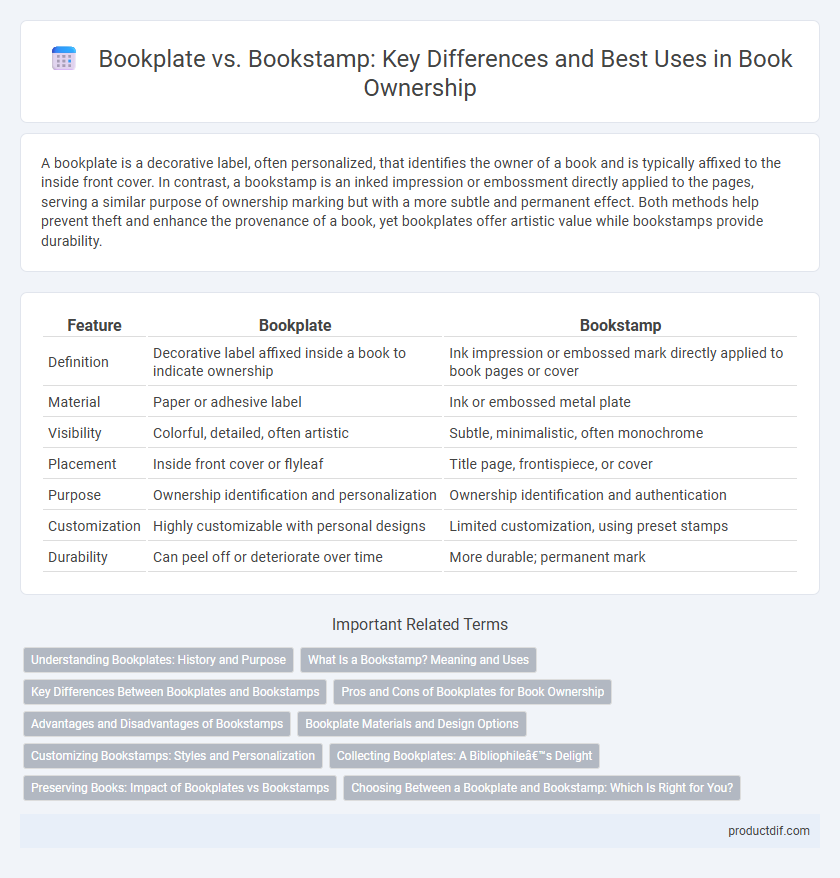A bookplate is a decorative label, often personalized, that identifies the owner of a book and is typically affixed to the inside front cover. In contrast, a bookstamp is an inked impression or embossment directly applied to the pages, serving a similar purpose of ownership marking but with a more subtle and permanent effect. Both methods help prevent theft and enhance the provenance of a book, yet bookplates offer artistic value while bookstamps provide durability.
Table of Comparison
| Feature | Bookplate | Bookstamp |
|---|---|---|
| Definition | Decorative label affixed inside a book to indicate ownership | Ink impression or embossed mark directly applied to book pages or cover |
| Material | Paper or adhesive label | Ink or embossed metal plate |
| Visibility | Colorful, detailed, often artistic | Subtle, minimalistic, often monochrome |
| Placement | Inside front cover or flyleaf | Title page, frontispiece, or cover |
| Purpose | Ownership identification and personalization | Ownership identification and authentication |
| Customization | Highly customizable with personal designs | Limited customization, using preset stamps |
| Durability | Can peel off or deteriorate over time | More durable; permanent mark |
Understanding Bookplates: History and Purpose
Bookplates, also known as ex libris, date back to the 15th century and serve as personalized labels indicating book ownership. Unlike bookstamps, which use ink impressions directly on pages, bookplates are typically decorative, printed or engraved paper affixed inside the book cover. Their historical purpose extends beyond identification to include artistic expression and the reflection of the owner's identity and status.
What Is a Bookstamp? Meaning and Uses
A bookstamp is an embossed or inked mark placed inside a book to indicate ownership, often featuring the owner's name, initials, or an emblem. Unlike bookplates, which are decorative labels glued to pages, bookstamps provide a more permanent, subtle impression that resists wear or removal. Bookstamps are commonly used by libraries, collectors, and institutions to deter theft and establish provenance.
Key Differences Between Bookplates and Bookstamps
Bookplates are personalized, decorative labels pasted inside books to identify ownership, often featuring intricate designs or family crests, while bookstamps use ink impressions or embossed marks directly applied onto the page for the same purpose. The key differences lie in their application method: bookplates are adhesive and removable, whereas bookstamps are permanent and less visually elaborate. Bookplates allow for artistic customization, whereas bookstamps prioritize durability and subtle identification.
Pros and Cons of Bookplates for Book Ownership
Bookplates offer a personalized and decorative way to indicate book ownership, often enhancing the book's aesthetic and sentimental value. They can be customized with names, designs, or mottos, making them ideal for collectors or gift-givers, but their adhesive may damage delicate or rare pages over time. Unlike bookstamps, bookplates are more visible and artistic, yet less durable, requiring careful placement to avoid wear and tear.
Advantages and Disadvantages of Bookstamps
Bookstamps offer a durable and cost-effective way to personalize books, providing a clear and consistent mark of ownership that resists fading over time compared to bookplates. However, bookstamps lack the decorative appeal and customization options of bookplates, which can diminish the aesthetic value of the book. The permanence of a bookstamp also means it is difficult to remove or alter, potentially reducing the book's resale value if ownership changes.
Bookplate Materials and Design Options
Bookplates typically feature a variety of materials including heavy paper, vellum, or adhesive labels, offering ample space for intricate designs such as heraldic symbols, personalized artwork, or calligraphy. Bookstamps are usually crafted from durable rubber or metal and provide a more subtle, embossed or inked impression directly on the book's endpaper or title page. Design options for bookplates emphasize customization and artistic expression, whereas bookstamps prioritize simplicity, durability, and ease of application.
Customizing Bookstamps: Styles and Personalization
Customizing bookstamps allows for a wide range of styles, from traditional motifs to modern minimalist designs, tailored to reflect the owner's personality or collection theme. Personalization options include selecting specific fonts, symbols, and ink colors, enhancing the bookstamp's visual appeal and uniqueness. Unlike bookplates, which are physical labels, bookstamps provide a seamless, ink-based mark that can be quickly applied, making them ideal for collectors seeking subtle yet distinctive identification.
Collecting Bookplates: A Bibliophile’s Delight
Collecting bookplates offers bibliophiles a unique glimpse into the history and ownership of rare books, showcasing intricate designs and heraldic symbols that reflect personal or family identities. Unlike bookstamps, which are often simple and functional, bookplates serve as miniature works of art, making them highly sought after by collectors worldwide. This distinct blend of artistry and provenance enriches the collector's experience, turning each bookplate into a prized artifact.
Preserving Books: Impact of Bookplates vs Bookstamps
Bookplates often enhance the preservation of books by providing a decorative, acid-free paper insert that protects pages and discourages theft, while offering a personalized artistic element. Bookstamps, typically ink-based imprints on a book's page or cover, may cause long-term damage through acid migration or paper degradation but are less invasive in terms of physical space. The choice between bookplates and bookstamps significantly impacts a book's longevity and condition, with bookplates generally favored by collectors and preservationists for maintaining value and structural integrity.
Choosing Between a Bookplate and Bookstamp: Which Is Right for You?
Selecting between a bookplate and a bookstamp depends on your personal style and preservation goals; bookplates offer a decorative, personalized label often featuring intricate designs and the owner's name, making them ideal for collectors seeking a traditional aesthetic. Bookstamps provide a subtle, durable imprint directly on the book's page, favoring minimalist and permanent ownership marks suitable for archival preservation. Consider the visual impact, permanence, and space available in your book when deciding which method best aligns with your collection's identity and longevity.
Bookplate vs Bookstamp Infographic

 productdif.com
productdif.com